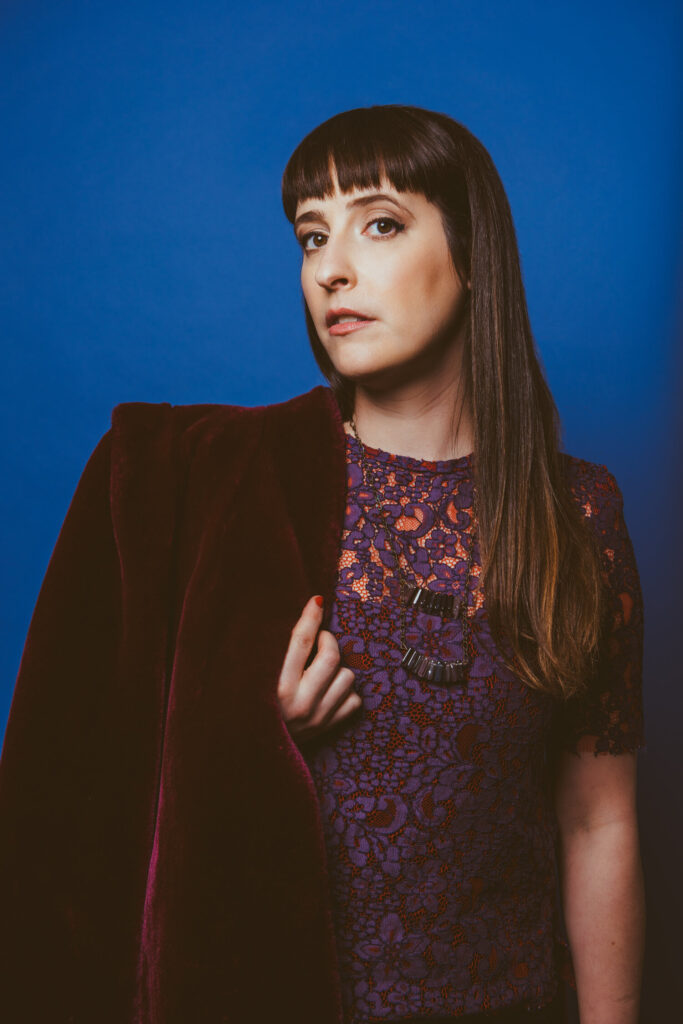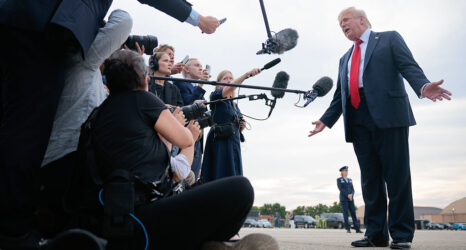“I think taking girls’ lives and stories and experiences seriously is a feminist act,” feminist writer Marisa Crawford told Ms.

Marisa Crawford has been writing about feminism, girl world and pop culture for years. The author of poetry collections Reversible and The Haunted House, as well as chapbooks 8th Grade Hippie Chic and Big Brown Bag, her next project is the anthology We Are the Baby-Sitters Club: Essays and Artwork from Grown-Up Readers which she co-edited and is forthcoming in July. (“More than a book about a series of books, it is an ode to the child readers we were, and the ways we have learned to name the experiences we couldn’t find written,” writes Melissa Febos about this book.)
Crawford’s writing about feminism and pop culture has appeared in The Nation, Harper’s Bazaar, BUST, VICE, Hyperallergic, Bitch, Ms., The Rumpus and elsewhere. She is the founder and editor-in-chief of WEIRD SISTER, a website and organization that explores the intersections of feminism, literature, and pop culture.
I met Marisa when our mutual interest in the poetry subgenre of the “gurlesque” began to collide at literary conferences and in other girl world spheres. After I read Reversible, I couldn’t stop thinking about how her rendering of the speaker’s teen girlhood was so well-encapsulated and how we need more visions of teen girlhood—both written by teens themselves, and women who look back at the significance of this time in their lives.
Elline Lipkin: I love the cultural frame within Reversible. You have such apt and exact references about music, décor, makeup, more, and how these underline relationships, moods and cultural moments.
How did you curate these to create the atmosphere you wanted to enact within your poems? Were you relying on memory or your own journals, anecdotes or mementos?
Marisa Crawford: I remember some of the experiences of being a teenager and a kid really vividly. That part of my life just feels really present to me. I have a poem in “Reversible” where I talk about when people are casually like, oh, I stumbled upon a box of old childhood mementos when I was at my mom’s house! I always feel slightly jealous when people say things like that, because I sort of wish that I could forget about the past long enough to be surprised by it, to, like, re-discover it.
Lipkin: In what ways do you see this as a feminist book? The mere capturing of teen girlhood, its angst, concerns, confusions, triumphs and raising these to the surface as valid and valuable seems feminist to me.
Crawford: Yeah exactly! I think our culture devalues and dismisses teen girls—and women in general too—constantly. Like, teen girls are a punchline. Remember that commercial from the 90s where the big joke was that a teen girl was the CEO of a company—like that would be totally impossibly hilarious.
I think taking girls’ lives and stories and experiences seriously is a feminist act. And many of the poems in Reversible reconsider the media that I and many others grew up on — songs, movies, TV shows, messages about food and bodies and dieting — through a grown-up contemporary feminist lens, thinking about how these different messages many of us took at face value at the time were actually often problematic and sexist too.
Lipkin: How did you pick the title and what are some of the nuances associated with the word “reversible” that made this so resonant for you?
Crawford: I was thinking about a green shirt that I got when I worked at a mall in Massachusetts that had exposed seams and could be worn inside and out. And I was thinking about time, and how I wore my mom’s clothes from the ’70s when I was a teenager in the ’90s and I had this romanticized vision of what the 1970s were like that I accessed and sort of appropriated through these clothes, and how that is often how clothing operates.
I also used those clothes to feel a connection to my mom and to her past and how her life informed my own. I still love wearing my mom’s old clothes. She had such amazing style and sometimes when I was younger she would see an outfit I had bought at the mall and she would comment that she never should have thrown away any clothes she’s ever owned because look, here her daughter was years later wearing the exact same styles which had come back into fashion.
That’s how memory is too: You should never throw anything away. You never know when you’ll need it or when it will come back in style or how it might connect you back to the past and some other part of yourself that you can’t understand yet. Velour bell bottom pants from your mom or a cassette tape of songs you recorded off the radio have the power to reverse time. And I was thinking about the quiet moment that we used to have in the 90s when you were sitting in your bedroom waiting for a tape to rewind to the beginning so you could listen to your favorite song. We don’t have that anymore.
Lipkin: Reversible captures a slice of ’90s teen girlhood in America. What do you think has most changed between the girlhood you’re depicting and someone who lives in similar socioeconomic, perhaps racial circumstances today—or has not much changed?
Crawford: I’m pretty disconnected from what teenagers’ lives are like today, but I love this quote from Judy Blume where she says that so much changes in how kids live their lives over time, but the feelings stay the same.
Lipkin: There is so much specificity about clothing and accessories within these poems—I love the “Punky Brewster-pink pencil hair barrettes I found at the Salvation Army,” and “the Betsy Johnson dress that Anais gave me at the clothing swap” and “Black lace dress with daisies on it from Express” (which I remember!). The narrator keeps a log of her outfits. When do these become signifiers within the text and why are sartorial choices so emblematic?
Crawford: Omg Elline! Please tell me you had the long black dress with daisies from Express. It was magical. I wanted to wear it for my confirmation (I was raised Irish-Catholic), but I think I ended up wearing some long purple skirt that I borrowed from my sister, with a cross my mom bought me that was filled with dried flowers.
Fashion is such a huge part of young women’s (and others’) identities, how you figure out who you are and what image of yourself you want to project to the world. Each piece of clothing and each hair clip feels so loaded and so powerful, and so emblematic of the moment. And then sometimes the clothes you wear are dictated by whatever dumb hand-me-down you can find in your sister’s closet. So, you become confirmed as a child of god or whatever that ritual is supposed to mean dressed as a kind of amalgamation of your mom and your sister and all their histories that come with their clothes, which is also a part of who each of us are too. Clothes let you say that you are not your mom or your sister but also you sort of are, just updated with different shoes and accessories.
Lipkin: Can you speak to the form of the book? How did you choose the long, loose lines that most of the poems are in?
Crawford: The older and more busy I get, the less time I seem to have for anything that doesn’t feel absolutely essential. I don’t always have time to put together elaborate outfits each day like I used to when I was younger, and that’s sort of how I feel about line breaks in my own writing. When I first started writing poetry, I thought they were an essential part of a poem, and I would think a lot about where to break lines. But more and more I see line breaks as forced, at least in my own writing. I like the straightforwardness of just letting words exist on the page without breaking them up in a way that, to me, can feel overly clever or crafted. I used to write prose poems a lot more, but sometimes I feel like the poem needs more room to breathe on the page, which has brought me to the longer lines.
Lipkin: Friendship is clearly a deep theme in the book—what it underlines and how it is signified. Can you say more about navigating the personal relationships with larger tropes of friendship for teenage girls, perhaps the restrictions or pressures placed around their friendships as well?
Crawford: Friendship is such a core part of how we form our identities at a young age. And I was so super obsessed with my friends when I was a teenager.
Right now I’m working on a project about The Baby-Sitters Club, and it’s had me thinking about how those books were such a foundational example of female friendship culture for me—and many others who read them growing up in the ’80s and ’90s. It’s just one example of how the models we see for female friendship influence us so profoundly for years to come.
From reading books about tight-knit, ride-or-die female friendships as a young girl to watching shows like Sex and the City in my early 20s, I feel like so much of female friendship culture sets up an expectation that friendships between girls and women should be sort of perfect and utopian—like this ecstatic, stable alternative to the chaos of navigating romantic relationships; Carrie, Miranda, Charlotte and Samantha meeting in a coffee shop like clockwork every weekend. I think my poems are exploring that idea, like, in some ways friendships with girls and women have served and still do serve as a super supportive space for me throughout my life, but also there’s so much pressure for those relationships to be perfect, to look a certain way, to be continuous, to be able to have these friends that you can on the phone every night or meet for coffee every week, and that’s often not realistic.
So how do these unrealistic models for female friendship end up serving us? How are kids, and girls in particular, raised to see themselves in relation to their friends, and how does this sometimes make us feel great, but sometimes make us feel even lonelier?
Lipkin: How long did you spend writing this book and is there more about your vision of teen girlhood to still tell? What’s next?
Crawford: I wrote these poems over the course of almost ten years. I think there’s always still more to tell and to explore—I’m working on a couple manuscripts of poetry, but have been focusing more on criticism and nonfiction writing lately. I’m working on a book of essays about ’90s pop culture and feminism. And I’m co-editing, with the amazing Megan Milks, an anthology of writing and art on the cultural impact of The Baby-Sitters Club, due out this July from Chicago Review Press.
Up next:





